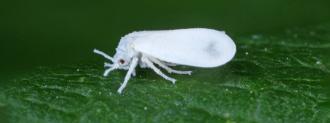Imagine if you could trade beneficial genes with your friends — you could give them your genes linked to a long life, while they’d hand over ones for disease resistance or lactose tolerance.
That’s not possible for humans — you can only get genes from your parents (who do exchange genes, but only to make you). But some organisms are able to swap genes directly with one another.
This is called “horizontal gene transfer,” and it’s common between bacteria, who use the process to gain defenses against antibiotics.
Plants and animals will also occasionally take genes from microbes (particularly viruses), but now scientists have discovered evidence that an insect once stole a gene from a plant.
Plant-to-Insect Gene Transfer
Whiteflies are the bane of farmers everywhere — the tiny bugs feed on more than 600 species of plants and cause hundreds of millions of dollars of damage every year.
Farmers spray pesticides to kill pests like the whitefly, but some plants have developed natural defenses, producing toxins designed to kill any pests that decide to eat them for dinner.
These toxins don’t seem to have any effect on whiteflies, though — they can freely munch on the plants that produce them.
Now, a Chinese-led team of researchers has discovered that the gene that plants use to protect themselves from their own toxins somehow ended up in whiteflies’ DNA.
By swiping this gene, millions of years ago, the whitefly was able to use plants’ own protection against them. This suggests that the bugs got their immunity through a horizontal gene transfer.
This exposes a mechanism through which we can tip the scales back in the plant’s favor.
Andrew Gloss
“This seems to be the first recorded example of the horizontal gene transfer of a functional gene from a plant into an insect,” researcher Ted Turlings from the University of Neuchâtel said in a press release. “You cannot find this gene…in any other insect species.”
The researchers suspect that whiteflies obtained the gene 35 million years ago, through a bizarre and unlikely series of events involving a virus.
“We think a virus within the plant may have taken up this (…) gene and, after ingestion by a whitefly, the virus then must have done something inside the insect whereby that gene was integrated into the (whitefly’s) genome,” Turlings said.
“Of course, this is an extremely unlikely event,” he added, “but if you think about millions of years and billions of individual insects, viruses, and plants across time, once in a while this could happen, and if the acquired gene is a benefit to the insects, then it will be evolutionarily favored and may spread.”
New Approach to Crop Protection
To see if they could use their knowledge of the horizontal gene transfer against the whiteflies, the Chinese researchers developed a molecule that would interfere with the bugs’ ability to express the gene (called BtPMaT1).
They then genetically modified tomato plants — which naturally produce the toxins — to produce that molecule. Finally, they let whiteflies and two other types of insects feed on those tomato plants, as well as unmodified controls.
You cannot find this gene…in any other insect species.
Ted Turlings
Less than 20% of the whiteflies died after feeding on the control plants, but nearly 100% died after eating the genetically modified plants. The mortality rates for the other insects were about equal for both plant types.
“This exposes a mechanism through which we can tip the scales back in the plant’s favor,” Andrew Gloss, an evolutionary genomics researcher at the University of Chicago in Illinois, who wasn’t involved in the study, told Nature.
“It’s a remarkable example of how studying evolution can inform new approaches for applications like crop protection.”
We’d love to hear from you! If you have a comment about this article or if you have a tip for a future Freethink story, please email us at [email protected].






